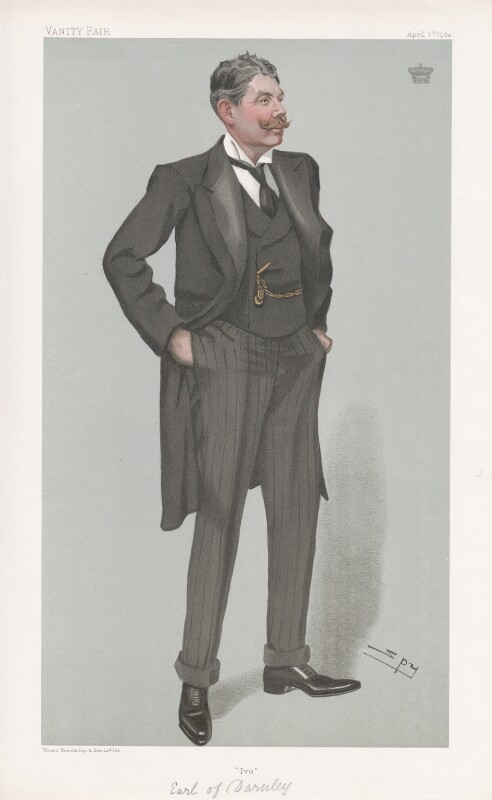
Caricature by "Spy" (Leslie Ward) in Vanity Fair, 1904
| ||||||||||||||||||||||||||||||||||||||||
| Personal information | ||||||||||||||||||||||||||||||||||||||||
|---|---|---|---|---|---|---|---|---|---|---|---|---|---|---|---|---|---|---|---|---|---|---|---|---|---|---|---|---|---|---|---|---|---|---|---|---|---|---|---|---|
| Full name | Ivo Francis Walter Bligh, 8th Earl of Darnley | |||||||||||||||||||||||||||||||||||||||
| Born | 13 March 1859 Westminster, London, England | |||||||||||||||||||||||||||||||||||||||
| Died | 10 April 1927 (aged 68) Shorne, Kent, England | |||||||||||||||||||||||||||||||||||||||
| Batting style | Right-handed | |||||||||||||||||||||||||||||||||||||||
| International information | ||||||||||||||||||||||||||||||||||||||||
| National side | ||||||||||||||||||||||||||||||||||||||||
| Test debut(cap 38) | 30 December 1882 v Australia | |||||||||||||||||||||||||||||||||||||||
| Last Test | 21 February 1883 v Australia | |||||||||||||||||||||||||||||||||||||||
| Domestic team information | ||||||||||||||||||||||||||||||||||||||||
| Years | Team | |||||||||||||||||||||||||||||||||||||||
| 1877–1883 | Kent | |||||||||||||||||||||||||||||||||||||||
| 1878–1881 | Cambridge University | |||||||||||||||||||||||||||||||||||||||
| Career statistics | ||||||||||||||||||||||||||||||||||||||||
| ||||||||||||||||||||||||||||||||||||||||
Background and education[edit]
Bligh was born in London, the second son of John Bligh, 6th Earl of Darnley, by Lady Harriet Mary, daughter of Henry Pelham, 3rd Earl of Chichester.[1] He was educated at Eton and Trinity College, Cambridge, graduating BA in 1882.[2] At Cambridge, he was secretary of the University Pitt Club.[3]
Cricket career[edit]
Although the history of Test cricket between England and Australia dates from 1877, it was after an English team led by Monkey Hornby lost to the Australians at The Oval in 1882, that The Sporting Times newspaper wrote a mock obituary to English cricket, noting that the body would be cremated and the ashes sent to Australia. The following winter's tour to Australia was billed as an attempt to reclaim the Ashes. Bligh's team was successful, winning the three-match Ashes series two-one, although a fourth game, not played for the Ashes, and hence a matter of great dispute, was lost.
A small terracotta urn was presented to the England captain Ivo Bligh by a group of Melbourne women after England's victory in the Test series. The urn is reputed to contain the ashes of a veil, ball, bail or, indeed, an old Aboriginal cricketer, symbolising "the ashes of English cricket". While the urn has come to symbolise the Ashes series, the term "The Ashes" pre-dates the existence of the urn. The urn is not used as the trophy for the Ashes series, and, whichever side "holds" the Ashes, the urn remains in the MCC Museum at Lord's. Since the 1998/99 Ashes series, a Waterford crystal trophy has been presented to the winners.
Bligh is commemorated by a poem inscribed on the side of the urn:
- When Ivo goes back with the urn, the urn;
- Studds, Steel, Read and Tylecote return, return;
- The welkin will ring loud,
- The great crowd will feel proud,
- Seeing Barlow and Bates with the urn, the urn;
- And the rest coming home with the urn.
Bligh also played for Cambridge University and Kent County Cricket Club in a first-class cricket career which lasted from 1877 to 1883. He was president of the Marylebone Cricket Club in 1900 and of Kent County Cricket Club in 1892 and 1902.
Public offices[edit]
Bligh succeeded his elder brother in the earldom in 1900. This was an Irish peerage and did not entitle him to an automatic seat in the House of Lords. However, in March 1905 he was elected an Irish Representative Peer. He was also a Deputy Lieutenant (appointed 1901) and Justice of the Peace for Kent.
Personal life[edit]
Lord Darnley married Florence Rose Morphy, daughter of John Stephen Morphy, of Beechworth, Victoria, Australia in 1884.[1] She had been a music teacher at Rupertswood, where her future husband had stayed during his tour of Australia. They had two sons and a daughter. Darnley died at Shorne, Kent, in April 1927, aged 68, and was succeeded in the earldom by his eldest son, Esmé. The Countess of Darnley presented the urn to the House of Lords after her husband's death. She died in August 1944.
His interment was in Cobham's Saint Mary Magdalene's churchyard.
No comments:
Post a Comment